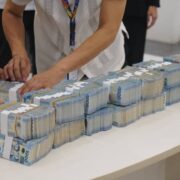Phase out ‘snubbed’ PH coins

Last week, the United States Treasury Department announced that by next year it will stop producing one-cent coins (or pennies) in compliance with the order of US President Donald Trump, who described them as “wasteful.”
According to the US Treasury, in the past 10 years, it cost 3.69 cents to produce the penny, which has been in circulation since 1793. With the phaseout, the Wall Street Journal said businesses would have to round prices up or down.
In 2012, Canada discontinued its one-cent coin to save on costs of minting and because its purchasing power had fallen amid higher prices. The United Kingdom had stopped minting 2-pence coins because more people were doing cashless transactions.
At present, the Philippine coins in circulation are in P20, P10, P5, P1, P0.25, P0.05 and P0.01 denominations. Depending on their indicated value, their components are nickel-brass, nickel-plated steel or bi-metallic, i.e., has copper nickel and aluminum bronze, all of which cost a lot of money to fabricate.
Recall that in 2023, the Bangko Sentral ng Pilipinas (BSP) installed coin deposit machines in malls in several parts of the country to encourage Filipinos to deposit their idle coins, whose values are then credited to their e-wallet or redeemed as shopping vouchers.
The machines, whose operation was recently suspended by the BSP for technical reasons, aimed to address coin shortages caused by hoarding and to improve the availability of coins for transactions.
The enthusiastic response to the scheme saved the BSP millions of pesos, which would otherwise have been spent to mint coins that are regularly used in daily commercial activities.
The coin collecting project was a welcome relief to Filipinos who did not know how to dispose of small-value coins they have accumulated through the years that languished in their cabinets or glass jars.
The BSP was able to cut costs further when it shifted from abaca to polymer in the production of the P1,000, P500, P100 and P50 banknotes, considering that the latter material is more durable and has a longer usage span.
If the BSP is still on a saving mood, it can take a leaf from the action of the US Treasury with regard to the 1-centavo and 5-centavo coins that commercial establishments have to maintain, among other coins, in their cash registers to comply with the law that requires them to give exact change to their customers.
But note that when those coins are given out, the customers often either leave them behind or drop them in tips or donation boxes on the cashier’s table. They are inclined to do that because those coins are hardly used to pay for goods and merely add to the weight of their coin purse.
Or if they happen to be philanthropically inclined, they would collect those coins and put them in the collection box of their church. That would be shooting two birds with one stone, i.e., getting rid of coin baggage and helping the church meet its financial obligations.
Try giving those coins to street urchins or panhandlers and they would most likely snub them or furtively throw them away. They would feel insulted by that measly dole out.
Despite their dire financial situation, they consider those coins worthless and useful only as play toys. And rare is the person who would pick up those coins when they see them on the street pavement.
The depreciation (if not loss) in utility value of those coins in daily commercial transactions is aggravated by the popularity and convenience of online transactions, e.g., GCash and Pay Maya, and the use of credit cards, which do away with rummaging through wallets or coin purses to pay for purchases.
Setting sentimentalities aside, it is apparent that those coins have already outlived their usefulness and no longer have a place in the commercial environment we are in at present.
Besides, with the way they have been snubbed in the past years, they would not be missed if they join the ranks of the country’s demonetized coins and banknotes.




















